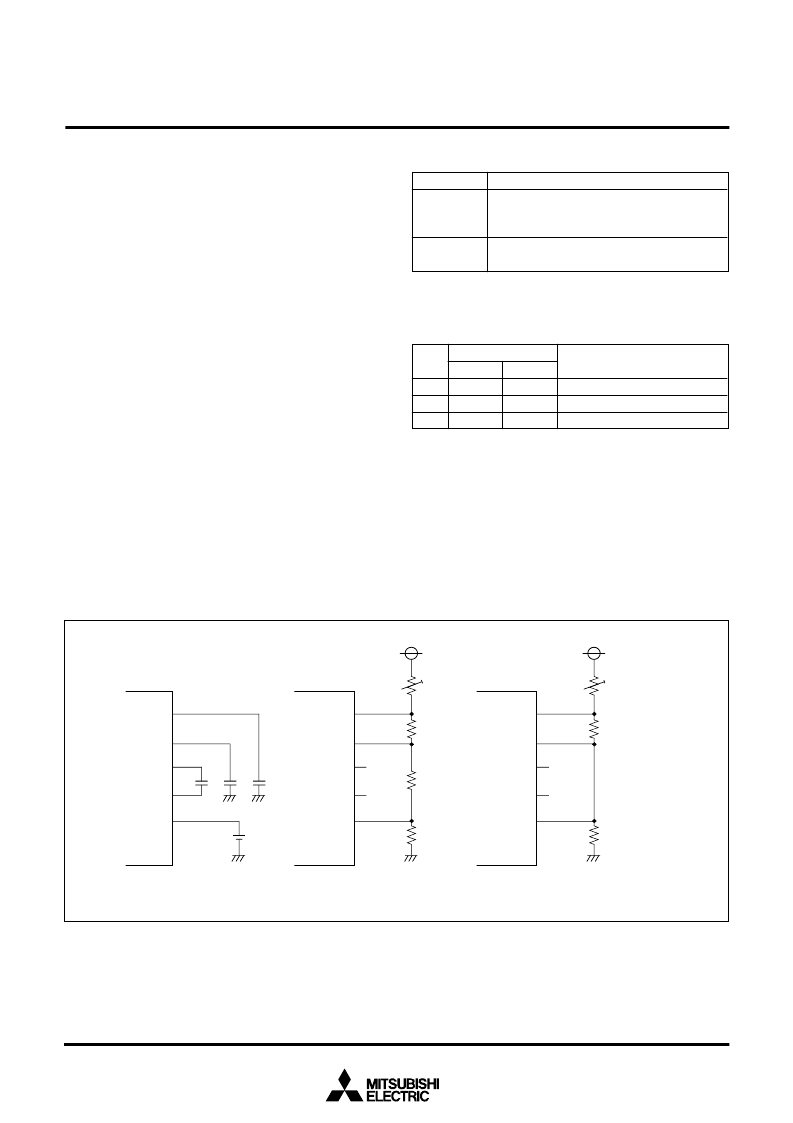- 您現(xiàn)在的位置:買賣IC網(wǎng) > PDF目錄370905 > M38258MCMXXXHP (Mitsubishi Electric Corporation) SINGLE-CHIP 8-BIT CMOS MICROCOMPUTER PDF資料下載
參數(shù)資料
| 型號: | M38258MCMXXXHP |
| 廠商: | Mitsubishi Electric Corporation |
| 英文描述: | SINGLE-CHIP 8-BIT CMOS MICROCOMPUTER |
| 中文描述: | 單芯片8位CMOS微機(jī) |
| 文件頁數(shù): | 32/70頁 |
| 文件大?。?/td> | 607K |
| 代理商: | M38258MCMXXXHP |
第1頁第2頁第3頁第4頁第5頁第6頁第7頁第8頁第9頁第10頁第11頁第12頁第13頁第14頁第15頁第16頁第17頁第18頁第19頁第20頁第21頁第22頁第23頁第24頁第25頁第26頁第27頁第28頁第29頁第30頁第31頁當(dāng)前第32頁第33頁第34頁第35頁第36頁第37頁第38頁第39頁第40頁第41頁第42頁第43頁第44頁第45頁第46頁第47頁第48頁第49頁第50頁第51頁第52頁第53頁第54頁第55頁第56頁第57頁第58頁第59頁第60頁第61頁第62頁第63頁第64頁第65頁第66頁第67頁第68頁第69頁第70頁

SINGLE-CHIP 8-BIT CMOS MICROCOMPUTER
MITSUBISHI MICROCOMPUTERS
3825 Group
32
Voltage Multiplier (3 Times)
The voltage multiplier performs threefold boosting. This circuit in-
puts a reference voltage for boosting from LCD power input pin
V
L1
. (However, when using a 1/2 bias, connect V
L1
and V
L2
and
apply voltage by external resistor division.)
The voltage multiplier control bit (bit 4 of the LCD mode register)
controls the voltage multiplier.
When voltage is input to the V
L1
pin during operating the voltage
multiplier, voltage that is twice as large as V
L1
occurs at the V
L2
pin, and voltage that is three times as large as V
L1
occurs at the
V
L3
pin.
When using the voltage multiplier; after applying 1.3 V
≤
Voltage
≤
2.3 V
to the V
L1
pin, set the voltage multiplier control bit to “1” to select the
voltage multiplier enable.
When not using the voltage multiplier, apply proper voltage to the
LCD power input pins (V
L1
–V
L3
).
Bias Control and Applied Voltage to LCD
Power Input Pins
To the LCD power input pins (V
L1
–V
L3
), apply the voltage shown
in Table 9 according to the bias value.
Select a bias value by the bias control bit (bit 2 of the LCD mode
register).
Common Pin and Duty Ratio Control
The common pins (COM
0
–COM
3
) to be used are determined by
duty ratio.
Select duty ratio by the duty ratio selection bits (bits 0 and 1 of the
LCD mode register).
Fig. 30 Example of circuit at each bias
Table 9. Bias control and applied voltage to V
L1
–V
L3
Bias value
1/3 bias
1/2 bias
Voltage value
V
L3
=V
LCD
V
L2
=2/3 V
LCD
V
L1
=1/3 V
LCD
V
L3
=V
LCD
V
L2
=V
L1
=1/2 V
LCD
Note :
V
LCD
is the maximum value of supplied voltage for the
LCD panel.
Table 10. Duty ratio control and common pins used
Duty
ratio
2
3
4
Common pins used
Notes 1:
COM
2
and COM
3
are open
2:
COM
3
is open
Bit 1
0
1
1
Bit 0
1
0
1
COM
0
, COM
1
(Note 1)
COM
0
–COM
2
(Note 2)
COM
0
–COM
3
Duty ratio selection bit
V
L3
V
L2
C
2
C
1
V
L1
1/3 bias
when using the voltage multiplier
V
L3
V
L2
C
2
C
1
V
L1
1/3 bias
when not using the voltage multiplier
Open
Open
R2
R1
R3
R1=R2=R3
Contrast control
V
L3
V
L2
C
2
C
1
V
L1
1/2 bias
Open
Open
R4
R5
R4=R5
Contrast control
相關(guān)PDF資料 |
PDF描述 |
|---|---|
| M38259EFGP | Quadruple Bus Buffer Gate With 3-State Outputs 14-SOIC -40 to 85 |
| M38258MCMXXXFP | SINGLE-CHIP 8-BIT CMOS MICROCOMPUTER |
| M38257M80090FP | IC LOGIC 1G08 SINGLE 2-INPUT POSITIVE-AND GATE -40+85C SOT-23-5 3000/REEL |
| M3825 | Single Chip 8 Bits Microcomputer(8位單片機(jī)) |
| M38254M6-064 | SINGLE-CHIP 8-BIT CMOS MICROCOMPUTER |
相關(guān)代理商/技術(shù)參數(shù) |
參數(shù)描述 |
|---|---|
| M3826 | 功能描述:電纜固定件和配件 LTRSCG 1000 BLACK RoHS:否 制造商:Heyco 類型:Cable Grips, Liquid Tight 材料:Nylon 顏色:Black 安裝方法:Cable 最大光束直徑:11.4 mm 抗拉強(qiáng)度: |
| M3826 BK001 | 制造商:Alpha Wire Company 功能描述:CBL 2COND 16AWG BLK 1000' |
| M3826 BK002 | 制造商:Alpha Wire Company 功能描述:CBL 2COND 16AWG BLK 500' |
| M3826 BK005 | 制造商:Alpha Wire Company 功能描述:CBL 2COND 16AWG BLK 100' |
| M3826 BK199 | 制造商:Alpha Wire Company 功能描述:CBL 2COND 16AWG BLK 3000=3000' |
發(fā)布緊急采購,3分鐘左右您將得到回復(fù)。